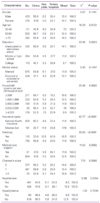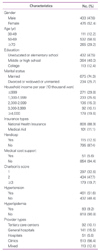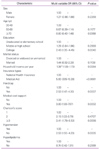Abstract
Deterioration in the health care delivery system has been a growing problem in Korea. The concentration of mild patients with chronic disease in tertiary care centers or general hospitals other than in clinics results in the distortion of functional differentiation among various types of providers. This brings about not a coordination of care through well-organized a referral system but an undesirable competition between clinics and hospitals. In this study, we used a multivariate binary logistic model to estimate the factors associated with the diabetes outpatients' choice of tertiary care centers (TCCs) or general hospitals as their usual source of care. Data were collected from the 2008 Korean Health Panel. The unit of analysis was a diabetes outpatient (n=910). Our study results showed that 56% of all of the diabetes outpatients studied only used clinics for their care during the year of 2008 followed by general hospitals (16%), mixed (12%), TCCs (10%) and hospitals (6%). Among the various types of providers, TCC or general hospital users had the highest out-of-pocket payments per visit, but the lowest number of visits, tests, and prescriptions during the year of 2008. According to our regression analysis, patients with higher education, income, and Charlson Comorbidity Index levels were more likely to use TCCs or general hospitals. Compared with patients who enrolled in the National Health Insurance program, Medical Aid program enrollees were more likely to visit TCCs or general hospitals. In addition, being enrolled in private health insurance or having any disability was also positively associated with the greater use of TCCs or general hospitals. Our findings suggest that policy-makers should take into consideration the characteristics of patients in implementing policies related to the healthcare delivery system. It is also necessary to employ diverse approaches, such as regulation and incentives considering patent characteristics to reform the current defective aspects of health care utilization and provision.
Figures and Tables
Table 2
Differences in diabetes outpatients' visiting patterns by the types of healthcare providers (n=910)

Table 3
Differences in diabetes outpatients' out-of-pocket payments per visit by the types of healthcare providers (n=907)

Table 4
Differences in the number of visits, tests and prescriptions per year by the types of healthcare providers (n=907)

References
1. World Health Organization. The world health report. 2004. Geneva: World Health Organization.
2. Chung SH, Woo KS, Choi CS, Hong JS, Son CW. Plans for chronic disease management in clinics. 2009. Seoul: Health Insurance Review & Assessment Service.
3. Cho SJ, Chung SH, Oh JY. Differences between diabetic patients' tertiary hospital and non-tertiary hospital utilization according to comorbidity score. Korean J Health Policy Adm. 2011. 21:527–540.

4. Kim KH, Lee JC, Kim HN, Choi JW. Study on strategic plan for chronic disease management in clinics. 2011. Seoul: Research Institute for Healthcare Policy, Korean Medical Association.
5. Lim DJ, Kwon HS, Kim HS, Lee JH, Ko SH, Lee JM, Kim SR, Lee WC, Son HS, Cha BY, Lee KW, Son HY, Kang SK, Yoon KH. Clinical characteristics of the diabetic patients managed at the different medical institutions in Seoul and Gyeonggi province. Korean J Med. 2006. 71:173–181.
6. Ministry of Health and Welfare. Korea Centers for Disease Control and Prevention. 2010 Korean National Health and Nutrition Examination Survey. 2010. Seoul: Ministry of Health and Welfare; Korea Centers for Disease Control and Prevention.
7. National Health Insurance Corporation. 2009 National health insurance statistical yearbook. 2010. Seoul: National Health Insurance Corporation.
8. Jeong KJ. Efficiency of medical service utilization in Korea: analysis using ACSC admission rate [dissertation]. 2008. Seoul: The Catholic University of Korea.
9. Charlson ME, Pompei P, Ales KL, MacKenzie CR. A new method of classifying prognostic comorbidity in longitudinal studies: development and validation. J Chronic Dis. 1987. 40:373–383.

10. Quan H, Sundararajan V, Halfon P, Fong A, Burnand B, Luthi JC, Saunders LD, Beck CA, Feasby TE, Ghali WA. Coding algorithms for defining comorbidities in ICD-9-CM and ICD-10 administrative data. Med Care. 2005. 43:1130–1139.

11. Dominick KL, Dudley TK, Coffman CJ, Bosworth HB. Comparison of three comorbidity measures for predicting health service use in patients with osteoarthritis. Arthritis Rheum. 2005. 53:666–672.

12. Oh HJ, Park JS, Park AR, Pyun SW, Kim YK. A study on revitalization of primary healthcare organizations through development of standard functions. J Korean Med Assoc. 2011. 54:205–216.

13. Kim J, Kim H, Kim H, Min KW, Park SW, Park IB, Park JH, Baik SH, Son HS, Ahn CW, Oh JY, Lee S, Lee J, Chung CH, Choi KM, Choi I, Kim DJ. Current status of the continuity of ambulatory diabetes care and its impact on health outcomes and medical cost in Korea using national health insurance database. J Korean Diabetes Assoc. 2006. 30:377–387.

14. Hurley RE, Gage BJ, Freund DA. Rollover effects in gatekeeper programs: cushioning the impact of restricted choice. Inquiry. 1991. 28:375–384.
15. Smith SR, Kirking DM. Access and use of medications in HIV disease. Health Serv Res. 1999. 34(1 Pt 1):123–144.
16. Weiss LJ, Blustein J. Faithful patients: the effect of long-term physician-patient relationships on the costs and use of health care by older Americans. Am J Public Health. 1996. 86:1742–1747.

17. Kim YK, Kim JS. A study on healthcare institution selection of healthcare consumers using theory of consumption values: focusing on relations among clinics or small sized hospitals, general hospitals, and large-sized hospitals. J Korean Soc Quality Manage. 2009. 37:71–86.
18. Lee JC, Kim KH, Kim HN, Park YH. Factors associated with the hypertension outpatients' choice of healthcare providers in Korea. J Korean Med Assoc. 2011. 54:961–970.

19. You CH, Kwon YD. Factors influencing medical institution selection for outpatient services. J Korean Med Assoc. 2012. 55:898–910.

20. Jung KT, Shin EK, Kwak CH. An empirical study on the relationship between private health insurance and moral hazard. Korean J Insur Med. 2006. 75:1–25.
21. Yoon HS. Effects of private insurance on medical expenditure. KDI J Econ Policy. 2008. 30:99–128.

22. Kang SW, You CH, Oh EW, Kwon YD. The impact of having private health insurance on healthcare utilization with controlling for endogeneity. Korean J Health Econ Policy. 2010. 16:139–159.
23. Shin YS, Choi BH, Shin HW, Hwang DK, Yoon SJ. Medical expenditure of medical aid patients and plans for their benefit extension. 2005. Seoul: Korea Institute for Health and Social Affairs.
24. Shin SM, Kim ES, Lee HW. Self-perception of the amount of medical aid use of outpatient over users in Korea. Korean J Health Policy Adm. 2009. 19:21–35.

25. Shin YS. On the appropriate use of health services. Health Welf Policy Forum. 2006. 114:91–101.
26. Shin HW, Shin YS, Hwang DK, Yoo WS, Choi KC, Lim SJ. Monitoring the designated doctor system. 2008. Seoul: Korea Institute for Health and Social Affairs.
27. Kim OS, Nam JJ, Kim MY, Koh IS, Lee DM. Study on the utilization of health care services of the medical aid patients. 2007. Seoul: Yonsei University Research Institute for Nursing Policy.
28. Arauz-Pacheco C, Parrott MA, Raskin P. The treatment of hypertension in adult patients with diabetes. Diabetes Care. 2002. 25:134–147.

29. Park BH. Health care policy making for primary care. J Korean Acad Fam Med. 1999. 20:953–958.




 PDF
PDF ePub
ePub Citation
Citation Print
Print




 XML Download
XML Download